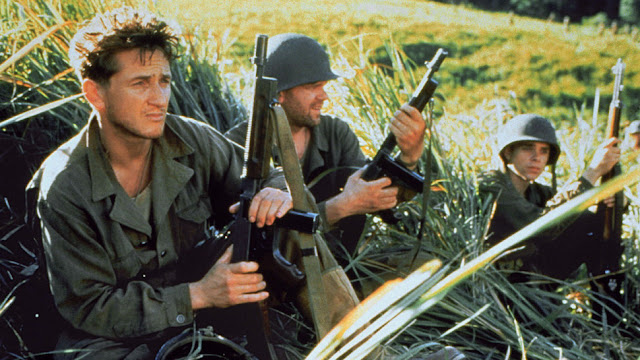In 1998, I was just young enough and naive enough to not know who Terrence Malick was as a filmmaker director of artistic movies. His body of work was considered closed at that time, with his last film, Days of Heaven, releasing in 1978, just two years after I was born. So I had no idea at the time who this director was nor what I could expect when I went with a few family members to see this film Christmas Day during its theatrical run. By this time, I had already seen Saving Private Ryan, and I just assumed this would be another film along those lines. I was wrong.
The Thin Red Line is not a movie about battles or saving a soldier, nor is it really about the war. It is an introspective look at humanity and how we exist in harmony with nature while fighting against that very nature by killing each other. The film has a lot of major actors in it with very few real characters. When the action does ramp up, we lose track of who is who and can only really keep a small semblance of who is who because of who is playing them. Many of the lesser-known faces just blend together into a hodgepodge of generic soldiers that could be anyone. This is not a representation of the James Jones novel upon which this film is based, where the characters were clearly defined, but an interpretation by Malick to get across a point-of-view consistent with the director himself.
The basis of the story comes from James Jones’ own experiences while serving in World War II. The majority of the plot revolves around the men of C Company, 1st Battalion, 27th Infantry Regiment, 25th Infantry Division, commanded by Capt. James Staros (Elias Koteas). These men have been brought to the island of Guadalcanal as part of the efforts to take Henderson Field, secure the island from the Japanese, and block off their route to Australia. Staros is ordered to lead his men on a direct assault on a bunker at the top of a hill that is heavily defended but he refuses to lead his men into this, believing it to be a suicide mission and proposes an alternate, roundabout attack. His superior, Lt. Col. Gordon Tall (Nick Nolte), insists on the direct assault. Tall catches up with the Battalion and, seeing that the resistance has seemingly lessened, makes up his mind that Staros is too weak-minded to be in command. He orders a flank attack on the bunker and, after a bloody assault, the Americans are victorious.
This film, like most of Malick’s movies, is introspective to a fault. There are so many moments throughout where we have long, lingering shots of soldiers looking up at the sky and hear their inner monologues about life, the war, and what it’s all really about. The problem is that those monologues do not fit in with the situations nor with the people themselves. All of these voice-overs are the same and are not tailored to the person they are supposed to represent. This is Malick himself interspersing his own perspective into a narrative that it doesn’t fit in with. This creates a schizophrenic feel to the whole ordeal, forcing us as the audience to marry together two different elements that don’t actually gel.
On top of this narrative, we also get cutaways to the various wildlife on Guadalcanal, everything from owls, bats, baby birds, and more, each either affected by the war around them or innocent observers of the soldiers. Malick is composing these scenes with a clear message that fails in its subtlety and symbolism. There is also a sort of prologue at the beginning of the picture where Private Witt (Jim Caviezel) has gone AWOL and is living with the carefree Melanesian natives in the South Pacific. These peaceful people have seemingly accepted him into their culture and live a life free from the darkness brewing elsewhere in the world. Later, Witt, now back in service, comes across some of the locals and discovers that the presence of the soldiers has caused them to have grown distant and distrustful, often fighting amongst themselves.
Like Saving Private Ryan, the battle scenes are expertly shot, and the scenery is beautiful and haunting at the same time. Cinematographer John Toll had a number of high-profile projects in the mid-to-late 1990s that earned him a lot of recognition, including three Oscar nominations, winning two. He is especially adept at capturing outdoor footage. His camerawork on The Thin Red Line often stays close to the ground, simulating how the soldiers would be seeing the world as they crawl through the tropical landscape. While there is some chaos on screen during battle sequences, this is done intentionally for the purpose of portraying the realities of the situation the soldiers are in. There is nothing on the level of Spielberg’s invasion of Normandy in Saving Private Ryan, but this film isn’t trying to do that kind of thing, anyway.
It would appear that, after such a long hiatus, everyone who is anyone was clamoring to work with the auteur. That would explain why there is such a large group of A-List celebrities in such minor roles throughout this production. The only real characters we get, roles that have any depth, are that of Staros and Tall. Staros risks his command when he refuses to blindly march his men to their deaths. He faces a court-martial by disobeying orders, but the lives of his men are more important to him. This is not a career soldier looking for glory on the battlefield. Because of that, it is rightfully pointed out that he doesn’t have the grit to be leading a battalion into battle, making the kind of sacrifices that position requires.
The opposite can be said about Gordon Tall, a man who reads Homer and dreams of glory. He doesn’t see his soldiers as anything more than a tool to get a job done. He has no sympathies when the men are collapsing from thirst or dying by the dozen to machine gun fire. All he cares about is the mission. His observations give you a good idea of his character: “The only time you worry about a soldier is when he stops bitching.” By being so cold and calloused, he may gain the day, but at what cost?
Like the best war pictures, Malick is determined to portray the enemy as the humans that they are rather than nameless villains. Like the infamous crater scene in All Quiet on the Western Front, we see the realities of the war and what it has ravaged on the Japanese, too. This is the kind of filmmaking that can be done now, nearly sixty years from the real war, that wouldn’t have been accepted by a viewing audience back in the day. Enough time has passed to allow feelings of animosity and hatred to die down and allow us to see the enemy soldiers as fellow human beings, many of whom don’t want to be there anymore than we did. Often the native Japanese is not translated into English, but it doesn’t need to be. We get what is being said, anyway. We also feel the sheer brutality on both sides as whatever measures are necessary are utilized to secure the island.
This is an amazing film to witness, but it is also a frustrating one. The singular voice of the monologging does more to create a distance between the audience and the characters than does the lack of character development. Without that character development, it becomes hard to have a central character that we can latch on to and follow over the course of the picture. Even Private Witt, whom we start the film with, is only in and out of the narrative sporadically and blends in with the nameless others more often than not.
The overall experience is mostly enlightening, if not quite entertaining. By not having a focal character, the film feels sporadic and incomplete. By being nearly three hours long, it also strains our patience. Still, it is a fantastic film for what it is. Don’t go into it thinking you’ll be getting an battle film with loads of memorable action set-pieces. This is not that film. Had I been familiar with Terrence Malick back in 1998, I would have been better prepared for the experience I was getting myself into. Watching it today, I was better prepared mentally and emotionally for the experience, and that made all the difference.
Academy Award Nominations:
Best Picture: Robert Michael Geisler, Grant Hill, and John Roberdeau
Best Director: Terrence Malick
Best Screenplay - Based on Material Previously Produced or Published: Terrence Malick
Best Cinematography: John Toll
Best Film Editing: Billy Weber, Leslie Jones, and Saar Klein
Best Original Dramatic Score: Hans Zimmer
Best Sound: Andy Nelson, Anna Behlmer, and Paul Brincat
____________________________________________________
Release Date: December 25, 1998
Running Time: 171 Minutes
Rated R
Starring: Sean Penn, Adrien Brody, Jim Caviezel, Ben Chaplin, George Clooney, John Cusack, Woody Harrelson, Elias Koteas, Nick Nolte, John C. Reilly, and John Travolta
Directed By: Terrence Malick










Comments
Post a Comment